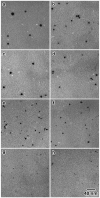Gold nanoparticle size controlled by polymeric Au(I) thiolate precursor size
- PMID: 18154334
- PMCID: PMC2544625
- DOI: 10.1021/ja076333e
Gold nanoparticle size controlled by polymeric Au(I) thiolate precursor size
Abstract
We developed a method in preparing size-controllable gold nanoparticles (Au NPs, 2-6 nm) capped with glutathione by varying the pH (between 5.5 and 8.0) of the solution before reduction. This method is based on the formation of polymeric nanoparticle precursors, Au(I)-glutathione polymers, which change size and density depending on the pH. Dynamic light scattering, size exclusion chromatography, and UV-vis spectroscopy results suggest that lower pH values favor larger and denser polymeric precursors and higher pH values favor smaller and less dense precursors. Consequently, the larger precursors led to the formation of larger Au NPs, whereas smaller precursors led to the formation of smaller Au NPs. Using this strategy, Au NPs functionalized with nickel(II) nitriloacetate (Ni-NTA) group were prepared by a mixed-ligand approach. These Ni-NTA functionalized Au NPs exhibited specific binding to 6x-histidine-tagged Adenovirus serotype 12 knob proteins, demonstrating their utility in biomolecular labeling applications.
Figures













Similar articles
-
Ni-NTA-gold clusters target His-tagged proteins.J Struct Biol. 1999 Sep;127(2):185-98. doi: 10.1006/jsbi.1999.4149. J Struct Biol. 1999. PMID: 10527908
-
Marine algae-mediated synthesis of gold nanoparticles using a novel Ecklonia cava.Bioprocess Biosyst Eng. 2014 Aug;37(8):1591-7. doi: 10.1007/s00449-014-1131-7. Epub 2014 Feb 14. Bioprocess Biosyst Eng. 2014. PMID: 24525832
-
Development of a histidine-targeted spectrophotometric sensor using Ni(II)NTA-functionalized Au and Ag nanoparticles.Langmuir. 2011 Dec 20;27(24):15330-9. doi: 10.1021/la202937j. Epub 2011 Nov 17. Langmuir. 2011. PMID: 22026818
-
Controlled synthesis and biomolecular probe application of gold nanoparticles.Micron. 2011 Apr;42(3):207-27. doi: 10.1016/j.micron.2010.09.008. Epub 2010 Oct 1. Micron. 2011. PMID: 20952201 Review.
-
Recent advances in polymer protected gold nanoparticles: synthesis, properties and applications.Chem Commun (Camb). 2007 Nov 28;(44):4580-98. doi: 10.1039/b707740h. Epub 2007 Jul 9. Chem Commun (Camb). 2007. PMID: 17989803 Review.
Cited by
-
Highly sensitive DNA detection using cascade amplification strategy based on hybridization chain reaction and enzyme-induced metallization.Biosens Bioelectron. 2015 Apr 15;66:520-6. doi: 10.1016/j.bios.2014.11.035. Epub 2014 Nov 26. Biosens Bioelectron. 2015. PMID: 25500528 Free PMC article.
-
Insights into the Biosynthesis of Nanoparticles by the Genus Shewanella.Appl Environ Microbiol. 2021 Oct 28;87(22):e0139021. doi: 10.1128/AEM.01390-21. Epub 2021 Sep 8. Appl Environ Microbiol. 2021. PMID: 34495739 Free PMC article. Review.
-
Genetically programmable thermoresponsive plasmonic gold/silk-elastin protein core/shell nanoparticles.Langmuir. 2014 Apr 22;30(15):4406-14. doi: 10.1021/la403559t. Epub 2014 Apr 8. Langmuir. 2014. PMID: 24712906 Free PMC article.
-
Multimodal Sensing Strategy Using pH Dependent Fluorescence Switchable System.Sci Rep. 2016 Dec 22;6:39452. doi: 10.1038/srep39452. Sci Rep. 2016. PMID: 28004748 Free PMC article.
-
Luminescent Gold Nanoparticles with Mixed Valence States Generated from Dissociation of Polymeric Au (I) Thiolates.J Phys Chem C Nanomater Interfaces. 2010;114(17):7727-7732. doi: 10.1021/jp9122584. J Phys Chem C Nanomater Interfaces. 2010. PMID: 20440379 Free PMC article.
References
-
- Salem AK, Searson PC, Leong KW. Nature Mater. 2003;2:668–671. - PubMed
-
- Shukla S, Priscilla A, Banerjee M, Bhonde RR, Ghatak J, Satyam PV, Sastry M. Chem Mater. 2005;17:5000–5005.
-
- Krämer S, Xie H, Gaff J, Williamson JR, Tkachenko AG, Nouri N, Feldheim DA, Feldheim DL. J Am Chem Soc. 2004;126:5388–5395. - PubMed
-
- Handley DA. In: Colloidal Gold: Principles, Methods, and Applications. Hayat MA, editor. Vol. 1. Academic Press, Inc.; San Diego: 1989. pp. 13–30.
-
- Frenkel AI, Nemzer S, Pister I, Soussan L, Harris T. J Chem Phys. 2005;123:184701. - PubMed
Publication types
MeSH terms
Substances
Grants and funding
LinkOut - more resources
Full Text Sources
Other Literature Sources

